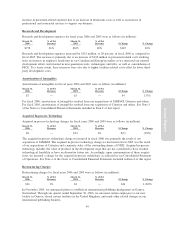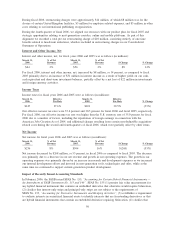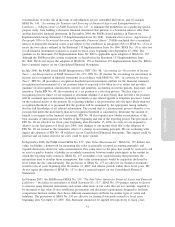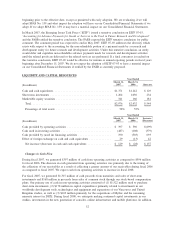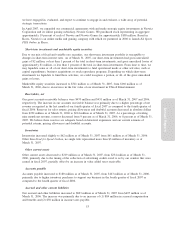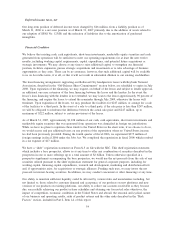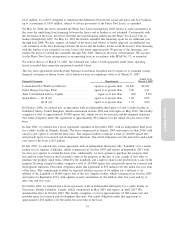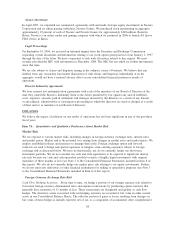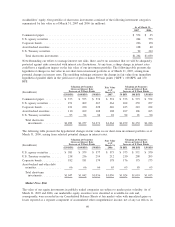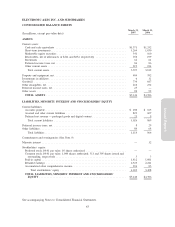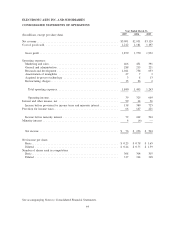Electronic Arts 2007 Annual Report Download - page 133
Download and view the complete annual report
Please find page 133 of the 2007 Electronic Arts annual report below. You can navigate through the pages in the report by either clicking on the pages listed below, or by using the keyword search tool below to find specific information within the annual report.
income in stockholders’ equity and subsequently reclassified into net revenue or operating expenses, as
appropriate in the period when the forecasted transaction is recorded. The ineffective portion of gains or losses
resulting from changes in fair value, if any, is reported in each period in interest and other income, net, in our
Consolidated Statements of Operations. Our hedging programs reduce, but do not entirely eliminate, the
impact of currency exchange rate movements in revenue and operating expenses. As of March 31, 2007, we
had foreign currency option contracts to purchase approximately $28 million in foreign currencies and to sell
approximately $72 million of foreign currencies. As of March 31, 2007, these foreign currency option
contracts outstanding had a total fair value of less than $1 million, included in other current assets. As of
March 31, 2006, we had no foreign currency option contracts outstanding.
Balance Sheet Hedging Activities. We utilize foreign exchange forward contracts to mitigate foreign currency
risk associated with foreign-currency-denominated assets and liabilities, primarily intercompany receivables
and payables. The forward contracts generally have a contractual term of approximately one month and are
transacted near month-end. Therefore, the fair value of the forward contracts generally is not significant at
each month-end. Our foreign exchange forward contracts are not designated as hedging instruments under
SFAS No. 133 and are accounted for as derivatives whereby the fair value of the contracts are reported as
other current assets or other current liabilities in our Consolidated Balance Sheets, and gains and losses from
changes in fair value are reported in interest and other income, net. The gains and losses on these forward
contracts generally offset the gains and losses on the underlying foreign-currency-denominated assets and
liabilities, which are also reported in interest and other income, net, in our Consolidated Statements of
Operations. As of March 31, 2007, we had forward foreign exchange contracts to purchase and sell
approximately $104 million in foreign currencies. Of this amount, $73 million represented contracts to sell
foreign currencies in exchange for U.S. dollars, $8 million to sell foreign currencies in exchange for British
pound sterling and $23 million to purchase foreign currencies in exchange for U.S. dollars. As of March 31,
2006, we had forward foreign exchange contracts to purchase and sell approximately $161 million in foreign
currencies. Of this amount, $132 million represented contracts to sell foreign currencies in exchange for
U.S. dollars, $14 million to sell foreign currencies in exchange for British pound sterling and $15 million to
purchase foreign currencies in exchange for U.S. dollars. The fair value of our forward contracts was
immaterial as of March 31, 2007 and March 31, 2006.
The counterparties to these forward and option contracts are creditworthy multinational commercial banks;
therefore, the risk of counterparty nonperformance is not considered to be material.
Notwithstanding our efforts to mitigate some foreign currency exchange rate risks, there can be no assurance
that our hedging activities will adequately protect us against the risks associated with foreign currency
fluctuations. As of March 31, 2007, a hypothetical adverse foreign currency exchange rate movement of
10 percent or 15 percent would result in a potential loss in fair value of our option contracts of $1 million in
both scenarios. As of March 31, 2006, we had no foreign currency option contracts outstanding. A hypothetical
adverse foreign currency exchange rate movement of 10 percent or 15 percent would result in potential losses
on our forward contracts of $9 million and $14 million, respectively, as of March 31, 2007, and $16 million
and $23 million, respectively, as of March 31, 2006. This sensitivity analysis assumes a parallel adverse shift
in foreign currency exchange rates, which do not always move in the same direction. Actual results may differ
materially.
Interest Rate Risk
Our exposure to market risk for changes in interest rates relates primarily to our short-term investment
portfolio. We manage our interest rate risk by maintaining an investment portfolio generally consisting of debt
instruments of high credit quality and relatively short maturities. Additionally, the contractual terms of the
securities do not permit the issuer to call, prepay or otherwise settle the securities at prices less than the stated
par value of the securities. Our investments are held for purposes other than trading. Also, we do not use
derivative financial instruments in our short-term investment portfolio.
As of March 31, 2007 and 2006, our short-term investments were classified as available-for-sale and,
consequently, recorded at fair market value with unrealized gains or losses resulting from changes in fair value
reported as a separate component of accumulated other comprehensive income, net of any tax effects, in
Annual Report
59


